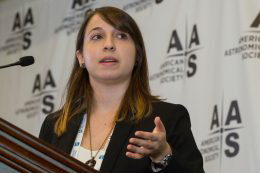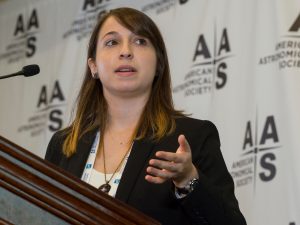Research by Redfield, Zachary ’17 Using Hubble, Voyager Probes Widely Reported


Wesleyan Associate Professor of Astronomy Seth Redfield and astronomy student Julia Zachary ’17 recently reported at the 229th meeting of the American Astronomical Society on their research using data from the Hubble Space Telescope combined with two Voyager spacecraft probes, both very long-lived and successful NASA missions. The findings were shared in dozens of news outlets from the U.S. to India to Afghanistan.
According to Nature.com, “The work is a rare marriage of two of the most famous space missions — and an unprecedented glimpse at the realm between the stars.”
“If the Voyager spacecraft and the Google Street View car are going around your neighborhood taking pictures on the street, then Hubble is providing the overview, the road map for the Voyagers on their trip through interstellar space,” Zachary said at a press conference held Jan. 6.
Astronomers have used instruments such as Hubble to obtain indirect measurements of the material in interstellar space. But the Voyager probes are giving them a direct taste of this mysterious environment, sending back data on the electron density of their surroundings. “As an astronomer, I’m not used to having measurements from the place I’m observing,” Redfield said.
SpaceDaily.com reports: “A preliminary analysis of the Hubble observations reveals a rich, complex interstellar ecology, containing multiple clouds of hydrogen laced with other elements. Hubble data, combined with the Voyagers, have also provided new insights into how our sun travels through interstellar space.”
“This is a great opportunity to compare data from in situ measurements of the space environment by the Voyager spacecraft and telescopic measurements by Hubble,” said study leader Seth Redfield of Wesleyan University in Middletown, Connecticut.
“The Voyagers are sampling tiny regions as they plow through space at roughly 38,000 miles per hour. But we have no idea if these small areas are typical or rare. The Hubble observations give us a broader view because the telescope is looking along a longer and wider path. So Hubble gives context to what each Voyager is passing through.”
Read more at Astronomy.com, The Indian Express, EarthSky.org and International Business Times. See photos of Zachary at the press conference on the American Astronomical Society’s website. A press release can be found on HubbleSite.
Redfield also is associate professor of integrative sciences.

